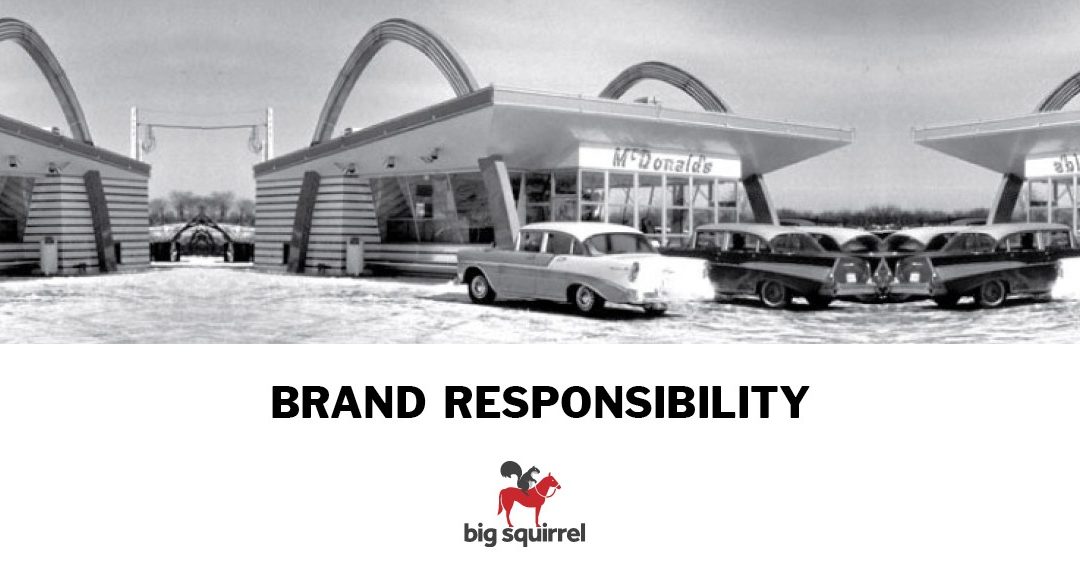
Brand Responsibility
What is the role of a brand when it comes to responsibility?
And we aren’t just talking about social responsibility and environmentalism, but the kind of responsibility that’s about helping consumers make good – or better – choices.
McDonald’s is at an interesting brand to consider when it comes to responsibility. For a brand that does so much good in the world – from the Ronald McDonald House to the Global Women’s Initiative – it is hard to believe that this same company also sells (gulp) fast food that has been accused of contributing to our country’s growing problem with obesity. Questions concerning responsibility are becoming more complicated. Should a fast food chain be held accountable for a problem it didn’t necessarily create? Or for that matter, should the brand be blamed for contributing to social issues just because the products it sells are unhealthy? Is McDonald’s any more guilty of promoting an unhealthy lifestyle than brands like Captain Crunch or Hershey’s? Where do we draw the line and who draws it when we begin to think about and debate brand responsibility?
McDonald’s is clearly thinking about this and has taken significant steps to respond to the growing trend of healthy living. They’ve expanded their product offering to include more health-conscious options like salads, milk, and apple slices. But, is this enough? Or are we to believe that the good they do as a company is enough to make up for selling fatty Big Macs?
For our first brand case study, we decided to explore the role of brand responsibility by taking a closer look at how McDonald’s is walking the line.
There are 6 key things that McDonald’s does that enables the company to give customers what they want (amazing french fries) while maintaining a sense of social responsibility:
1) MCDONALD’S MAINTAINS A HIGH LEVEL OF TRANSPARENCY THAT BUILDS TRUST WITH
CONSUMERS AND EMPLOYEES.
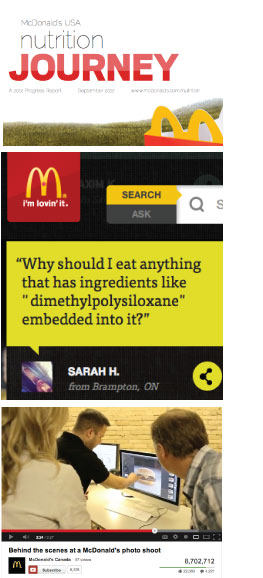 Example: Nutrition Progress Report
Example: Nutrition Progress Report
In 2012, McDonald’s published its first ever nutrition progress report, revealing the company’s nutritional performance over the past year. The report is easily accessible online to anyone who is interested. For the report, McDonald’s hired Ernst & Young LLP to conduct an independent examination of McDonald’s progress against its commitment goals. The report highlights focus on three key nutrition commitments: Children’s Well-being, Nutritionally Balanced Menu Choices, and Nutrition Information and Education.
Read more directly from McDonald’s here.
Example: Our Food. Your Questions.
In 2012, McDonald’s opened up communication lines with the social media campaign and website called “Our Food. Your Questions,” that allows customers to submit queries to McDonald’s Canada, which then answers some of them with videos.
One result of this campaign is a very honest, behind the scenes look at why a McDonald’s burger in an advertisement looks so different than one a consumer purchases in the restaurant. With this kind of open communication present, consumers instill more trust in the brand.
See the YouTube video here.
2) MCDONALD’S MAINTAINS AN OPEN AND FLEXIBLE FRAMEWORK THAT HONORS LOCAL PREFERENCES.
Example: Global Parents’ Table
McDonald’s established a global Parents’ Table in March, 2012. The membership is comprised of 10 parents and dads from the U.S., U.K., Australia, France, Spain, Brazil, Mexico and Taiwan. McDonald’s met with the Parents’ Table twice to focus on how the company can play a positive role in children’s well-being.
Read more directly from McDonald’s here.
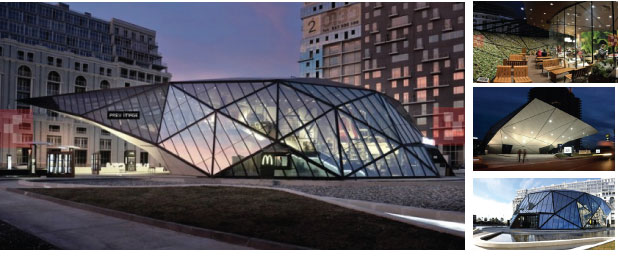
Example: Giorgi Khmaladze designed space in Georgia
McDonald’s embraced a design by architect Giorgi Khmaladze in Batumi, Georgia, leaving behind cues that are commonly associated with the restaurant. The result is a stunningly modern space that takes brand into an entirely new space and creates a new experience for the average McDonald’s customer:
On the inside there is a creative use of space, semi-private seating, beautiful wood paneling, and what appears to be some sort of grass field in the upper part of the building (where it is the most tapered). The grass area is actually an elevated garden with huge skylights, so people can eat small, rectangular apple pies with a natural backdrop and lot of sunlight.
Read more about the McDonald’s of the future on geek.com and on PSFK.
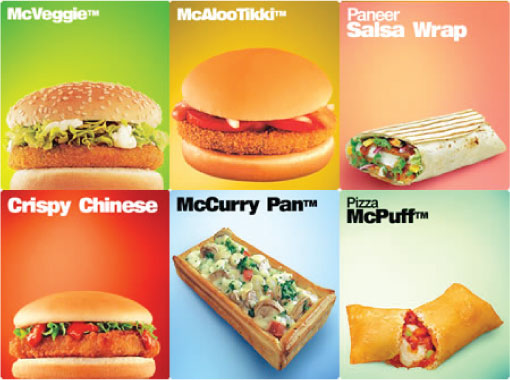
Example: Regional menu items
McDonald’s doesn’t simply duplicate local cuisine, rather the corporation puts a “McDonald’s twist” on it, creating menu items that incorporate local flavors but that maintain a sense of consistency and fit the brand. McDonald’s maintains a sensitivity to local customs and preferences and creates menu options using local suppliers. For example, when they introduced the Parmigiano Reggiano burger in Italy, they formed an alliance with the official Consortium of Parmigiano-Reggiano, made up of 650 small, artisanal cheese producers in Northern Italy.
Read more directly from McDonald’s here.
3) MCDONALD’S IS IN TOUCH WITH THE NEEDS AND VALUES OF CONSUMERS ACROSS THE GLOBE.
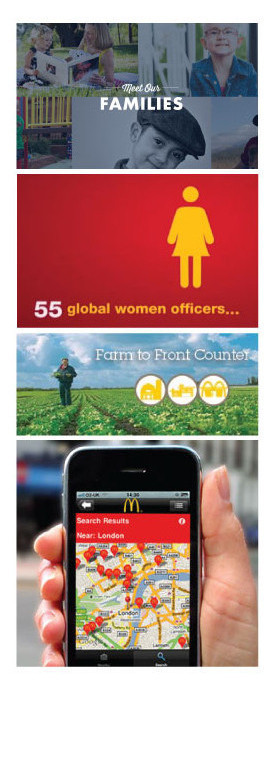 Example: Ronald McDonald House Charities
Example: Ronald McDonald House Charities
The mission of Ronald McDonald House Charities (RMHC) is to create, find and support programs that directly improve the health and well being of children. The House program provides a “home-away-from-home” for families so they can stay close by their hospitalized child at little or no cost. McDonald’s Corp. is the largest corporate donor and McDonald’s employees are dedicated volunteers. Owners / operators participate in local and global RMHC board.
Example: Global Women’s Initiative
Supports the recruitment, development, and advancement of women at all levels of the company while creating a culture where women have the opportunity to succeed and grow.
Watch the YouTube video here.
Example: 5 sustainability focus areas
McDonald’s sustainability efforts expand beyond just the environment and into general well-being. The overarching goal of McDonald’s sustainability efforts is focused on continuous improvement through five focus areas: Nutrition & Well-Being, Sustainable Supply Chain, Environmental Responsibility, Employee Experience, and Community.
Example: Mobile Payment App
McDonald’s is currently testing a new mobile app that lets customers order via mobile phone and pick up food in stores, curbside or at drive-thru windows. As we move closer to a cashless society, McDonald’s is looking for ways to incorporate new technologies into the brand experience.
4) MCDONALD’S MASTERFULLY BALANCES VALUE (BUYING) AND EXPERIENCE (SHOPPING).
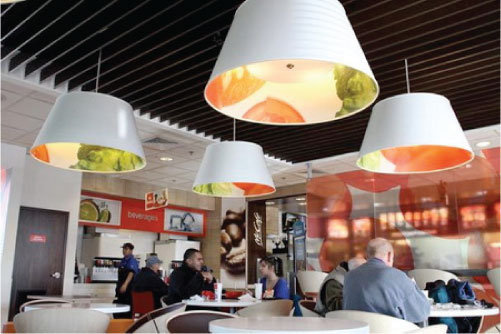
Example: McDonald’s restaurant remodel
McDonald’s recognizes the importance of creating an experience that matches the direction in which the brand is headed. By beginning a $2.9 billion remodeling effort in 2012, the brand hopes to “gain broader acceptance for top-tier times that are already on the menu like smoothies and Angus burgers and to better compete with the fast-casual industry.”
Keeping pace with the changing lives of consumers, “the company is moving to seating “zones”: slow zones for coffee sippers enjoying the Wi-Fi, fast zones at high bar tables for single diners wolfing down a sandwich and family zones with booths for parents to “lock” their children on the inside to prevent them from wandering.”
This remodel effort combines McDonald’s value with the quality and comfort of a higher-end restaurant, creating a better overall brand experience.
Read more about McDonald’s remodel in the Chicago Tribune.
5) MCDONALD’S EMPOWERS EMPLOYEES AND CUSTOMERS TO BETTER THEMSELVES.
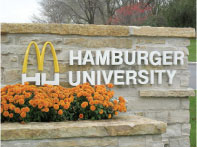 Example: Hamburger University
Example: Hamburger University
In 1961, McDonald’s founder Ray Krocs launched a training program, later called Hamburger University, at a new restaurant in Elk Grove Village, Illinois. There, franchisees and operators were trained in the scientific methods of running a successful McDonald’s. Hamburger U also had a research and development laboratory to develop new cooking, freezing, storing and serving methods. Today, more than 80,000 people have graduated from the program.
Example: Diversity Curriculum
McDonald’s has developed an internal “diversity curriculum” that teaches employees how to move from awareness to action in the area of inclusion and intercultural management.

The courses include:
Asian Pacific Middle East Career Development
Black Career Development
Hispanic Career Development
Lesbian Gay Career Development
Women’s Career Development
Intercultural Learning Lab
Read more about McDonald’s diversity program in Forbes.
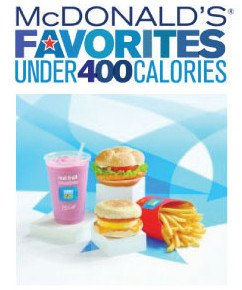 Example: Menu expansion
Example: Menu expansion
McDonald’s strives to help consumers make more informed choices. Over the past few years they have expanded the menu to include low calorie items like smoothies, egg whites on breakfast sandwiches and the sandwiches that include cucumbers and other vegetables. According to McDonald’s CEO Don Thompson, the chain’s best known items, such as Big Macs, fries and chicken nuggets, account for just 25 percent of the chain’s sales.
In 2012, McDonald’s introduced a “Favorites Under 400” menu that highlights the calorie information for items to help put calorie counts into context for customers. They company also promised to list calorie counts on restaurant and drive-thru menus.
McDonald’s is also introducing a voluntary nutrition e-learning program for their employees to help build employees’ knowledge of calories, nutrition and McDonald’s menu offerings.
Read more about McDonald’s and nutrition in the Chicago Tribune.
6) MCDONALD’S GIVES CONSUMERS CONTROL BY ENABLING THEM TO MAKE INFORMED DECISIONS.
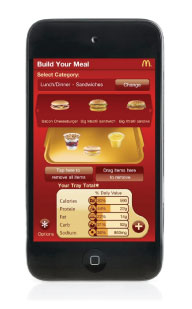 Example: My Meal Builder & McDonald’s App
Example: My Meal Builder & McDonald’s App
McDonald’s enables customers to access nutritional information quickly and easily for all of McDonald’s food and beverages through their app and website. Consumers can create and tailor meals that suit their individual needs using the My Meal Builder feature on the website. McDonald’s has also begun including calorie information on their overhead menus and drive-up menus.
What role do you think brands should play in influencing the decisions we make as consumers?
We’d love to hear your thoughts.